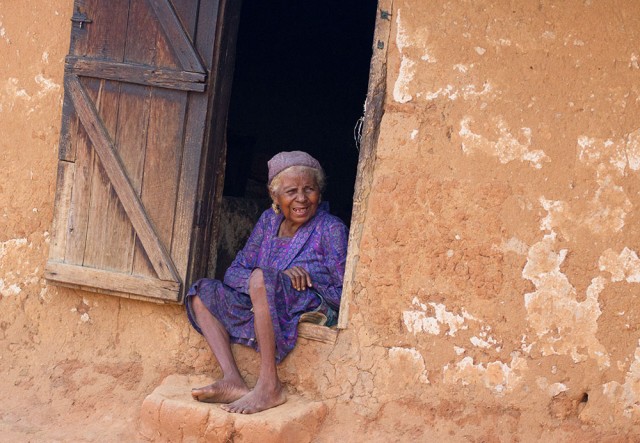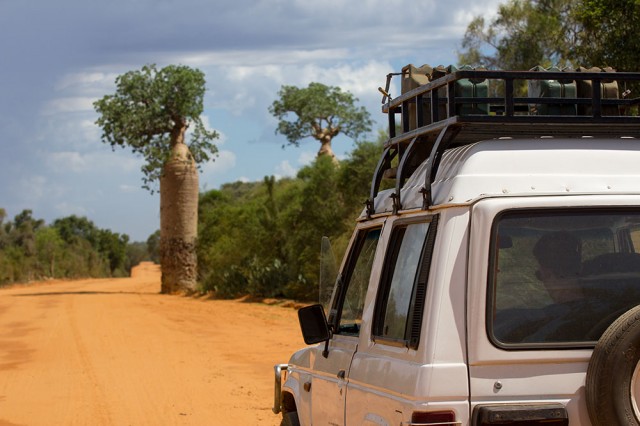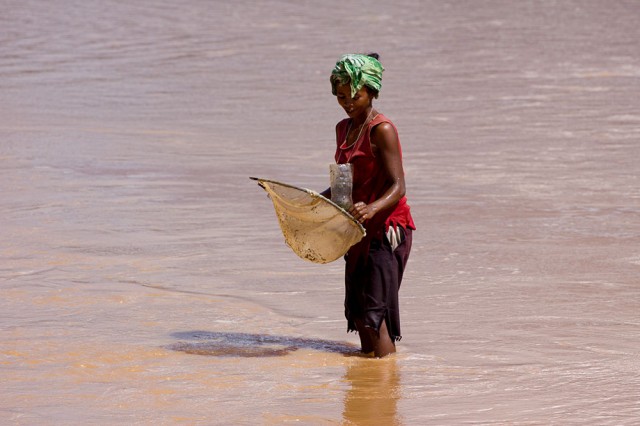Madagascar, the Red Island of Africa, is sometimes described this way not because of its socialist past, but because of the color of the local soil. This island was once covered almost entirely with green rainforest, but the slash-and-burn agricultural technique of local farmers has led to heavy erosion over time. Today, throughout the country, the reddish color dominates the soil. While driving there, red dust quickly covered all our belongings inside the cabin.
Near the town of Ambalavao, we stopped to see the Zebu market, the largest in Madagascar. While parking near the market, a group of local children surrounded our car. They peered inside and asked for something, but we were not sure what they really wanted. Unfortunately, we did not have any cookies that children always took very willingly. In broken mix of several languages, we tried to find out what they wanted. To no avail, children still insisted on something inside our car. After some time, my wife realized, “they must be thirsty, let’s give them the water these kids are pointing to.” We had only one partially empty bottle of water that we decided to give them. One boy quickly grabbed it and ran away. To our surprise, he did not drink the water but poured the entire contents on the ground. With an empty bottle, the boy disappeared from our sight between countless cattle in the market area. That behavior extremely surprised us. Later, we understood that Malagasy people live on an average of two USD per day. Thus, these used empty plastic bottles are a real treasure if they can be found or acquired. They can be used for storing milk or water, or can probably have hundreds of other uses. From this experience on, we always gave empty bottles to kids we encountered along the way.
While driving in the southern part of Madagascar we passed through gemstone-rich areas. Small mining towns on the way looked richer than the ones we had seen before. Gem dealers’ “palaces” dominated in the area. In front of each of these establishments were cars shining from a newly applied wax coat, a stark contrast to the surrounding dust. To show high status and wealth these houses were built entirely of concrete. They had glass windows and decorative balcony railings. All of this seemed very strange because the architectural styles and materials used were almost completely unknown in the local construction industry. These homes were also places where local miners traded their rough colored gems such as sapphires, rubies, etc. There were no large mines with mineshafts in the area. As we saw, gem mining here was simply digging underground tunnels without any safety measures, taking dirt out to the surface and sluicing it in a nearby river.
Excited to see baobabs we reached Ifaty Spiny Forest, on the shores of the Mozambique Channel. It was an area where plants adapted to prolonged periods of drought. The Ifaty area, with many small fishing villages, seems to be a quite isolated part of the island. Malagasy live there in a very harsh environment and rely mostly on fish as their main source of food. The local population is more similar to the black Africans as opposed to the inhabitants of the east part of the island who look similar to people of Indonesia. The west coast populace builds simple grass huts in the same way their ancestors did centuries ago. Almost everyone walks around barefoot here. Women often cover their faces with mud in order to protect their skin against sunburn.
In the eastern part of the island, in the mountainous region of Madagascar’s Central Highlands, there is a tribe revered for their wood carving talents. They are known as Zafimaniry. Their houses and art are unique among all Malagasy ethnic groups. After a few hours on the dirt roads, driving mostly across rice fields, we entered the village of Antoetra. Almost immediately, dozens of people surrounded our car. Everyone was trying to say something, but we could not understand what they were saying. We came here to see the traditional mountain village. At first glance, it was not a very picturesque location. We expected unique wooden houses, but it was hard to find them here. After a long conversation, we realized that local rules required us, as they said to pay a visit to the community house to see the president of village. He greeted us warmly and requested a fee for a visit. It was 10,000 airary (around 4 USD) per person.
While waking in the village we were invited to see the interior of one of the houses. It turned out to be a home of an important elder. He showed us that traditional Zafimaniry wooden houses were erected without nails. There are not so many of them in Antoetra, the community we visited. This is because of high price of wood, which is now hard to get due to deforestation. It is cheaper to build out of clay or use other materials. When we entered the old chief’s house, we found the simplest interior you can imagine. There was only one room with small windows and no glass. There were no beds or any other furniture; there was no stove, no sink, and no running water, not to mention a bathroom. There was absolutely nothing inside except woven mats on one side, an open fire on the other and a few small everyday items by the wall. The house had no chimney and smoke filled the entire interior. Smoke blackened the ceiling and internal walls. Our host without wasting any time started to explain. “Our homes always have a traditional setting, where each corner has a special meaning; the most important is the northeast corner of the room where we pray to our ancestors.” It actually made sense. Most of the Malagasy tribes share common ancestors that arrived centuries ago not from Africa, as many may think, but from Asia, today’s Indonesia, probably Borneo, an island, which lies in the northeast direction from Madagascar. “The northern part of the house where you are sitting is reserved for men and guests. The southeast corner is a place to store water. The northwest part of the house is where we keep our tools”—the elder continued—“and finally the southwest corner is for the hens.” It was the moment we noticed a cage near the door. The host added—“chickens are safe here from other animals and people who may steal them.”
Madagascar is very exotic destination, far away from mass tourism. I have to admit that the Pajero aka Tractor cooperated very well and we had no major issues with the car. We drove almost 2,500 km/1,550 miles in total and had the best time you can imagine. If you like off-road adventures and unique social and environmental experiences, this island is the perfect location for you to explore.

















